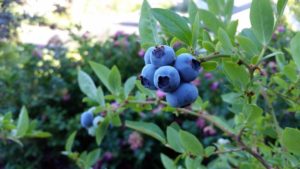Grow Your Own – Bl oo berries
Grow Your Own
Who says growing your own blueberries has to be hard?
We’ve put together a handy guide that will have you enjoying the little blue superfoods from your backyard in no time.
Make it a family project and have everyone involved in watering and caring for your new blueberry plants. You’ll be rewarded with an abundance of fresh berries each harvest (that you can use in our delicious recipes found here!).
Blueberries love warm, sunny days and clear, cool nights.
So what’s stopping you? Read on and get planting!
Pick the right location
Full sun, with moist well-drained soil
What do blueberries bushes need to get the best harvest of beautiful berries every year?
Location, location, location. Choosing the right spot in your garden is the most important first step.
Like most fruits, blueberries do best when they have full sun all day. They can cope with a bit of shade, but if you want lots of blueberries off your bushes, they need to be planted in full sun.
They also prefer moist soil that is free-draining and has lots of organic matter. If your garden has heavy clay soil, you will need to add plenty of other materials like good quality compost or peat moss before you plant your blueberry bushes.
Unlike most other fruits, blueberries need soil with an acidic pH: ideally between 4.0 and 5.0. Remember water is pH neutral at 7 so blueberries really like their acid! If you have neutral or alkaline soil, you are going to need to lower the pH considerably before planting your blueberry bushes or they will not thrive at all.
You can get a soil tester at your local home & garden centre and make sure you follow the instructions carefully.
How do you lower the pH of your soil?
Add organic matter – You can add organic matter to your soil annually for a gradual pH-lowering effect – peat is an excellent choice. But, not in heavy clay soils – you need to call in the big guns!
Add aluminum sulfate – it creates acidity in the soil instantly as soon as it dissolves. Find it at your local garden centre or hardware supplier
Add sulfur – this is cheaper than aluminium sulphate but is also slower to act
What is the right variety for your garden?
From humble beginnings in Australia in the 1970’s, there are now plenty of varieties of blueberries available for the home gardener. The varieties that can be grown in Australian climates are broken down into three main groupings.
Northern highbush: these are cold climate blueberries that must have cold winters in order to set fruit. They are relatives of Vaccinium corymbosum that comes from the Great Lakes area of northern America. These bushes lose all their leaves in winter and can put up with very cold winters. These are the varieties that are mostly grown in Victoria and Tasmania as well as other cooler regions. Fruit from these varieties grown in cooler climates with ripen in December and continue until about April.
Southern highbush: These have the lowest need for winter chilling. They come from the southern USA and are mixed or ‘hybrid’ varieties mainly resulting from crosses between Vaccinium darrowii with Vaccinium corymbosum. Southern Highbush varieties grow well in coastal and warm inland regions from Sydney all the way up to far North Queensland. These are the most tropical-loving of the blueberry varietal families.
Depending on the location, these bushes will keep all of their leaves over winter – or just shed a few. The plants are generally semi-deciduous or evergreen depending on the climate. Fruit from this variety starts to ripen in late winter an continues through into mid-summer.
Rabbiteye: This funny-named family are low chill varieties, but can cope with moderately cool climates. They are derived from Vaccinium ashei and when the fruit is fully ripe it is similar in colour to the other types, but when immature it is the soft pink colour of a rabbit’s eye – hence the name!
Rabbiteye varieties are known to be strong & sturdy plants that start to fruit slightly later in the season that the Southern Highbush types. Like their Southern Highbush cousins, Rabbiteye plants can lose some of their leaves or remain evergreen through the colder months depending on their location. Fruit starts to ripen in late spring and continues throughout summer.
Plant the right variety
Different blueberry varieties are suited to different climates
Read more:






